The trek to Ciudad Perdida, the Lost City has been our most memorable hike in Latin America to date. These ancient ruins are located deep in the Sierra Nevada de Santa Marta, a mysterious region of Northern Colombia that is full of exotic animals, venomous insects and indigenous people.
It is a place with a dark past, for years greedy grave robbers pilaged tombs and sacred sites searching for gold, the bloody cocaine industry flourished in the foothills and military conflict raged in the dense rainforest. A lot has changed since then, and it is now considered one of the best hikes in the country.
We trekked for 5 days in the Sierra Nevada de Santa Marta to one of the most sacred sites of the ancient Tayrona people, The Lost City. For those wondering about choosing a good camera, don’t forget to check out our guide How To Choose The Best Camera For Travel.These photos taken with my Sony NEX 6 will give you a brief glimpse into this beautiful and mysterious area of South America.
[thrive_leads id=’51961′]
SIERRA NEVADA DE SANTA MARTA
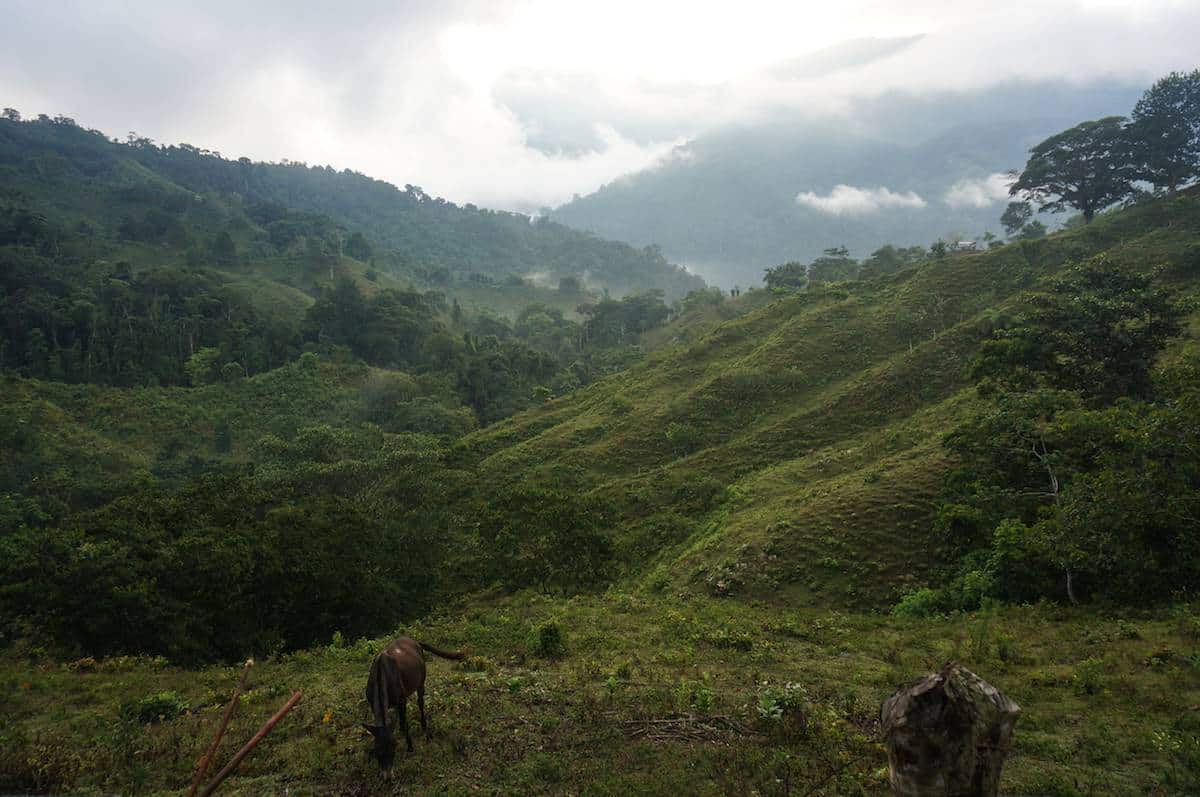
The sierra represents the entire planet in miniature, every climate that you find on earth can be found here. The mountains meet the sea, where it is very hot and lush. Only 40 km (25 miles) from the beaches there are snow-capped mountain peaks over 5,700 meters (18,700 ft) tall. There are parts that are pure desert and others that are cloud forest.
In recent times, the sierra provided refuge for people escaping the political dramas of the country. Colombians came here to build farms, however they found it very difficult work for very little money. Two crops they did find to rake in the cash were marijuana and cocaine. These fields you see below were once covered in coca and marijuana plants. Over the last few years, and with heavy backing from the U.S, the Colombian government has eradicated these plantations.
RIVER CROSSINGS
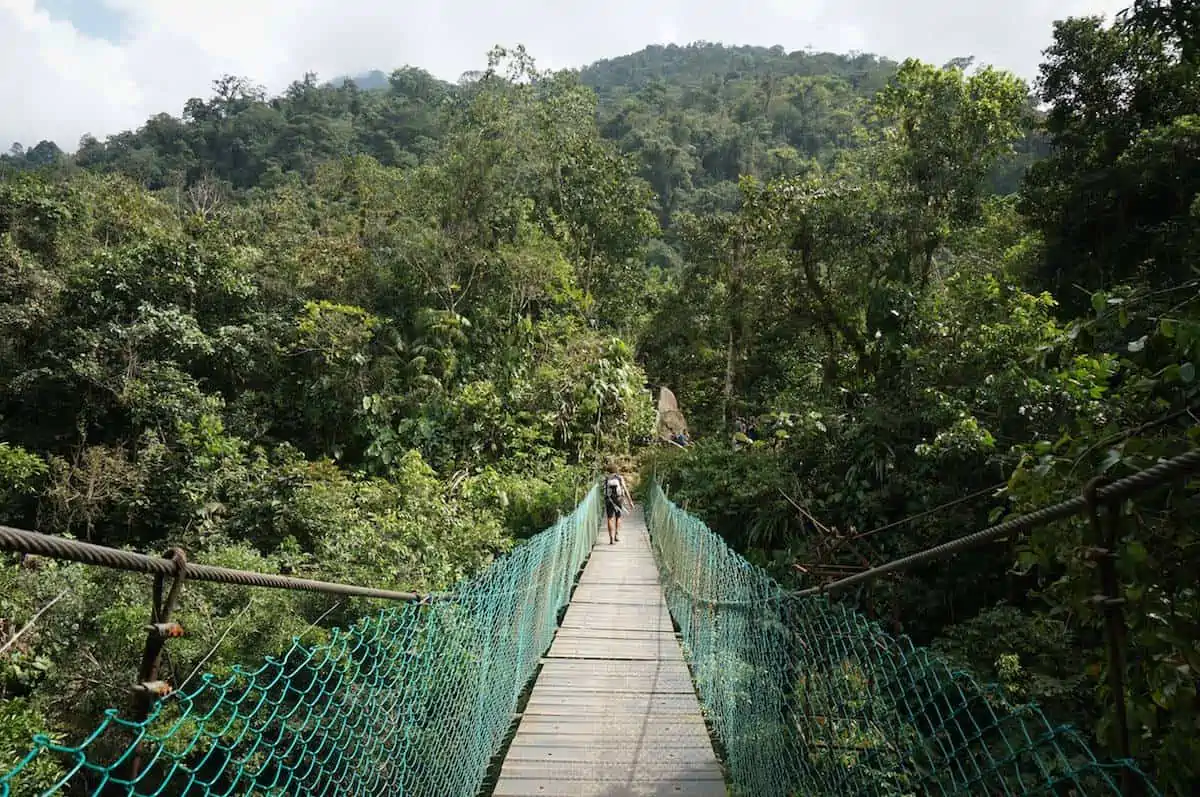
The trail to the Lost City crosses the Burataca river many times. Most crossings are done by foot but here this high pass is accessible by bridge.
TRAIL TRANSPORT
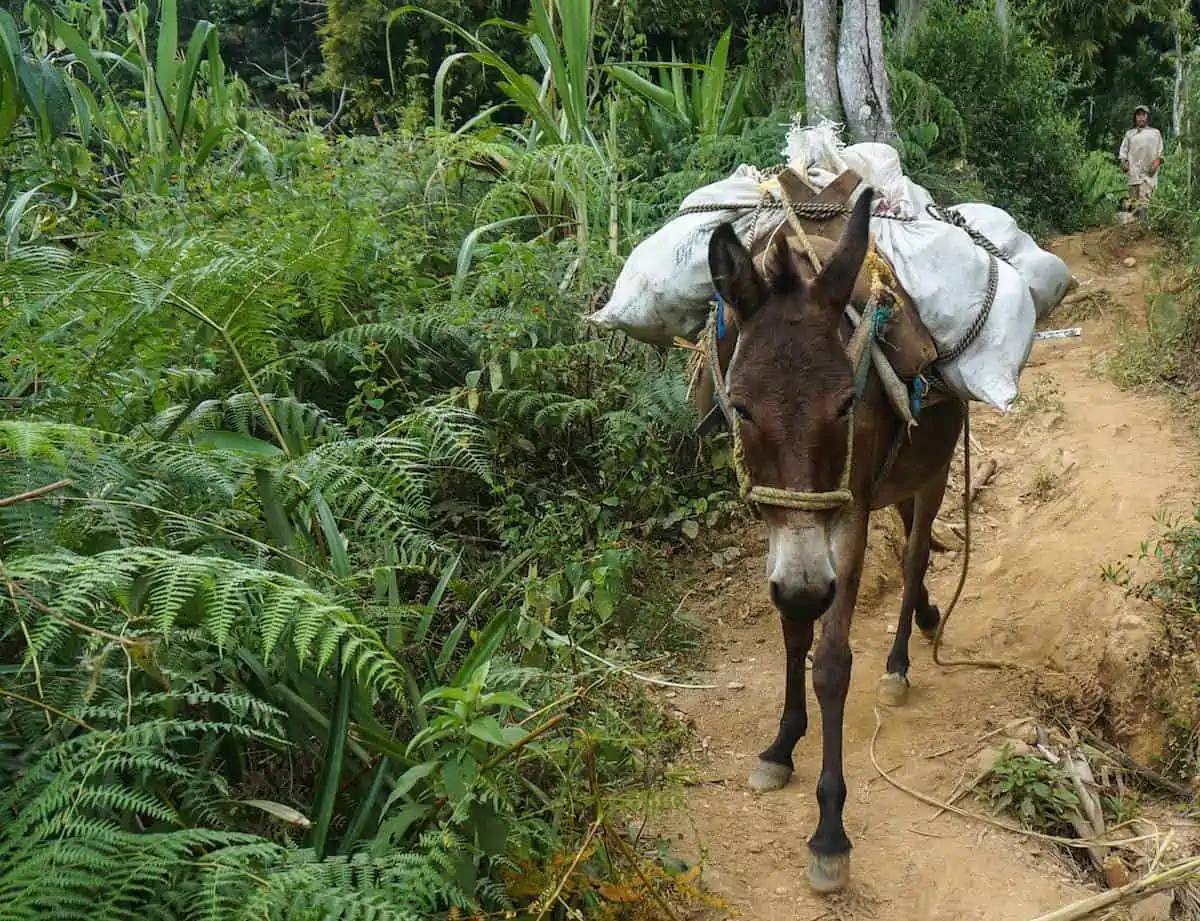
This 44 km hike of steep climbs and descents is demanding. Luckily hikers only need to carry a small pack with clothes and water while these hardworking mules carry all the food and supplies to the camps.
LUSH RAINFOREST
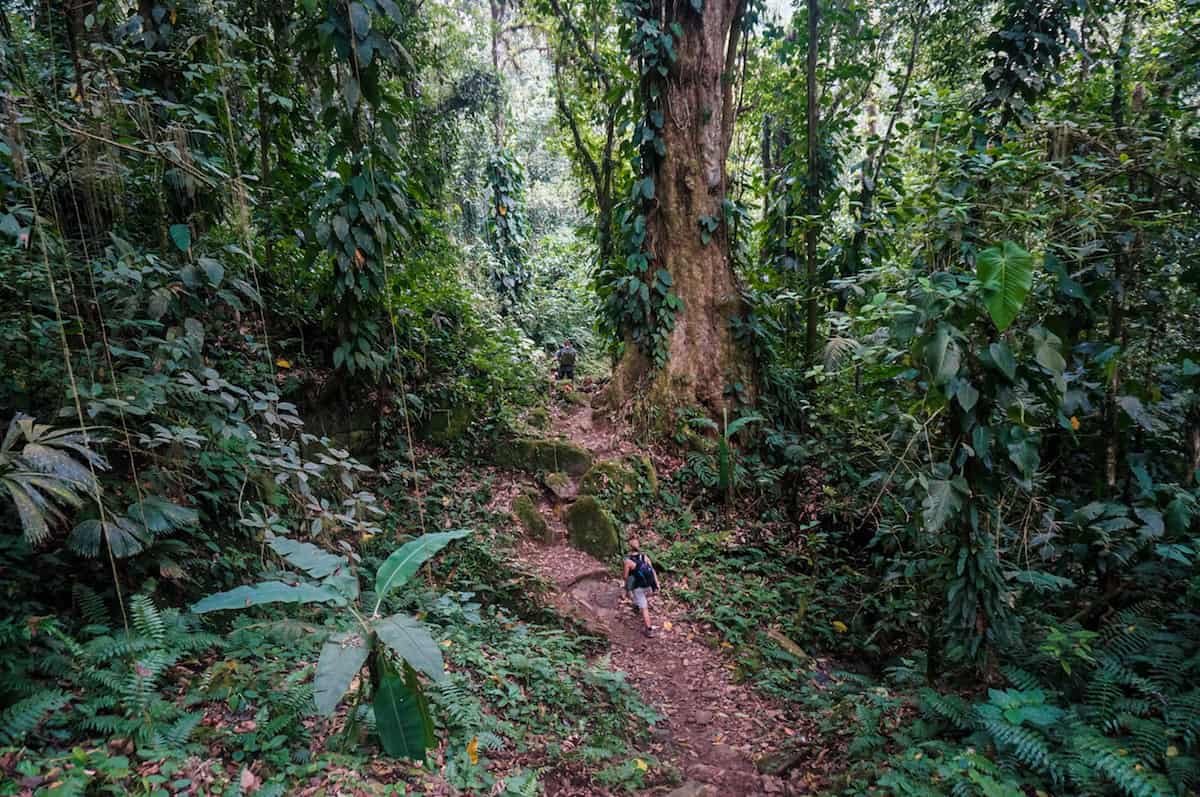
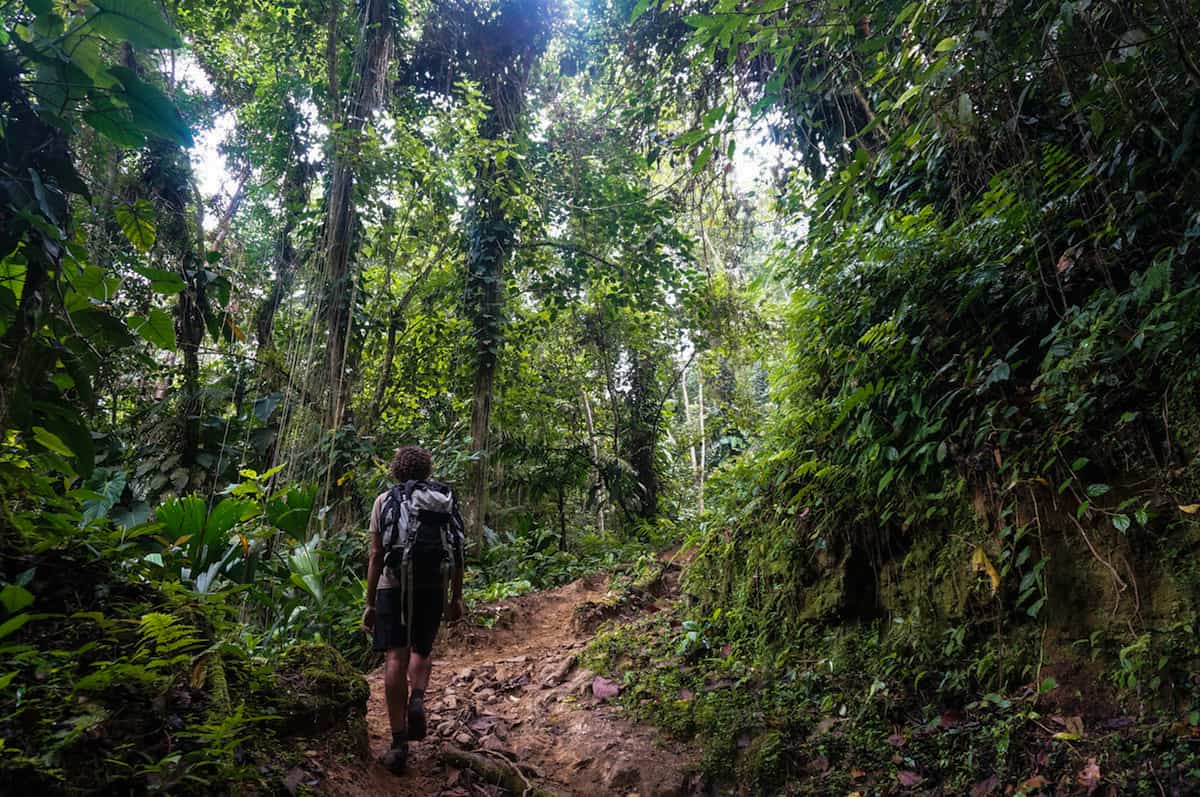
The majority of the hike took us through the lush, green rainforest. The tree on the right is huge in comparison to the hiker next to it, it must have first sprouted thousands of years ago.
This area was once effected by the Colombian armed conflict between the Colombian National Army, right-wing paramilitary groups and left-wing guerrilla groups and Revolutionary Armed Forces of Colombia (FARC). The dense jungle of the sierras was a perfect hide out for these groups. In recent years the Colombian government has taken strong actions to secure the area and have set up many military bases throughout the sierra.
IN THE CLEAR
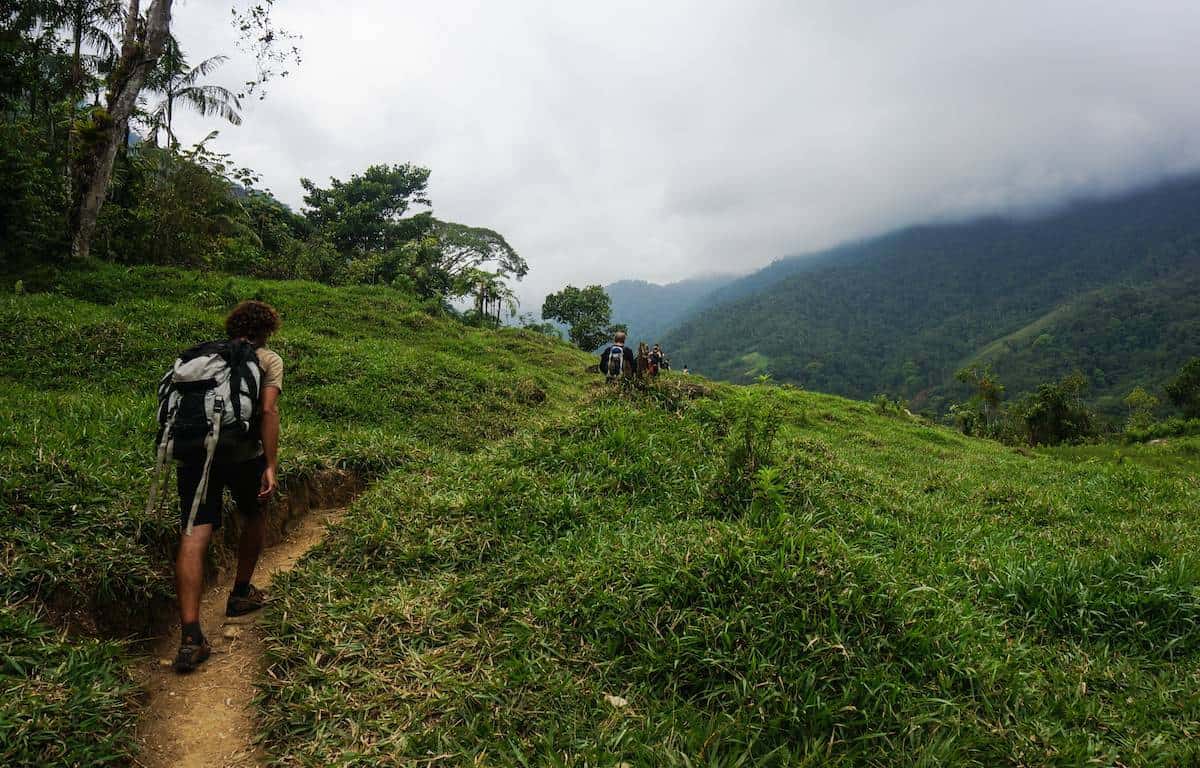
Some of the most spectacular parts of the trail are when we came to a clearing and were surrounded by the rolling foothills of the sierra. The flat clearings are also a nice break from seemingly constant up and down of the trail.
HOME FOR THE NIGHT
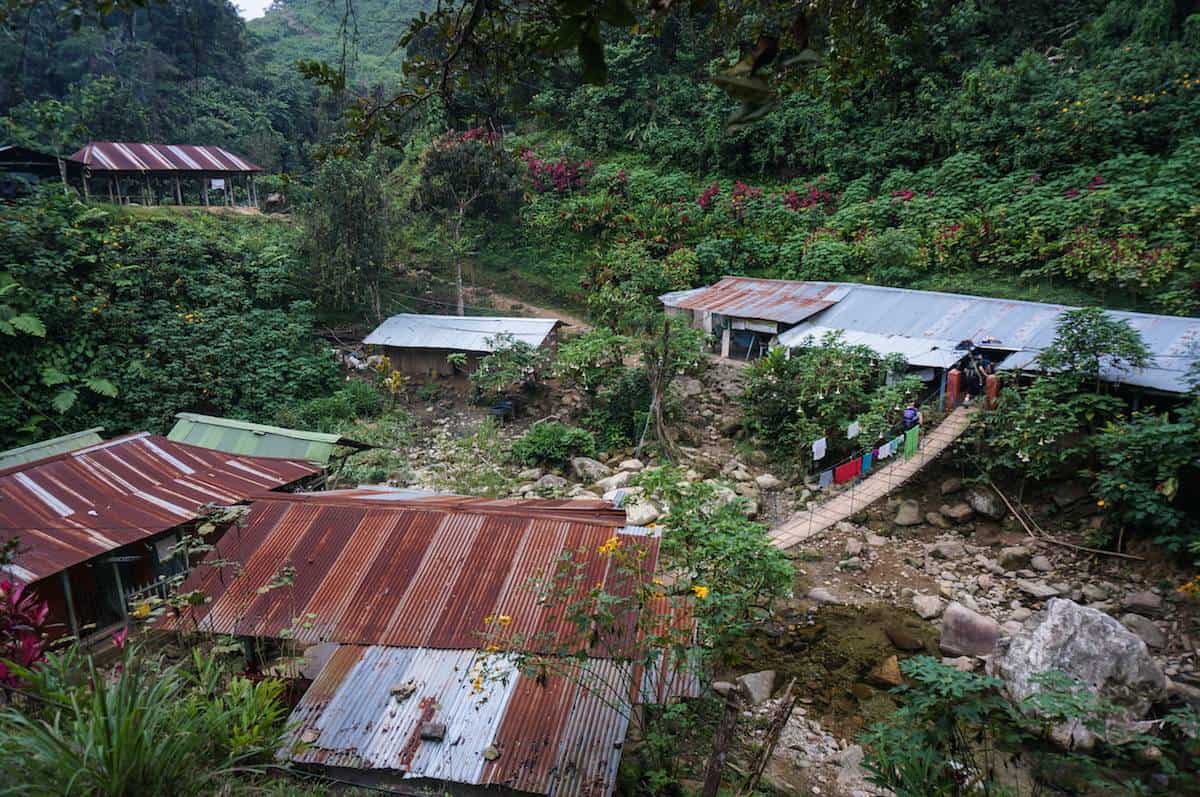
Throughout the trail there are several camps set up. Here we camped the first night at Adan. It is by far the most luxurious camp as it has lots of beds, hammocks and a swimming hole with a cliff jump. There is even electricity, which means cold beer!
CAMP KITCHEN
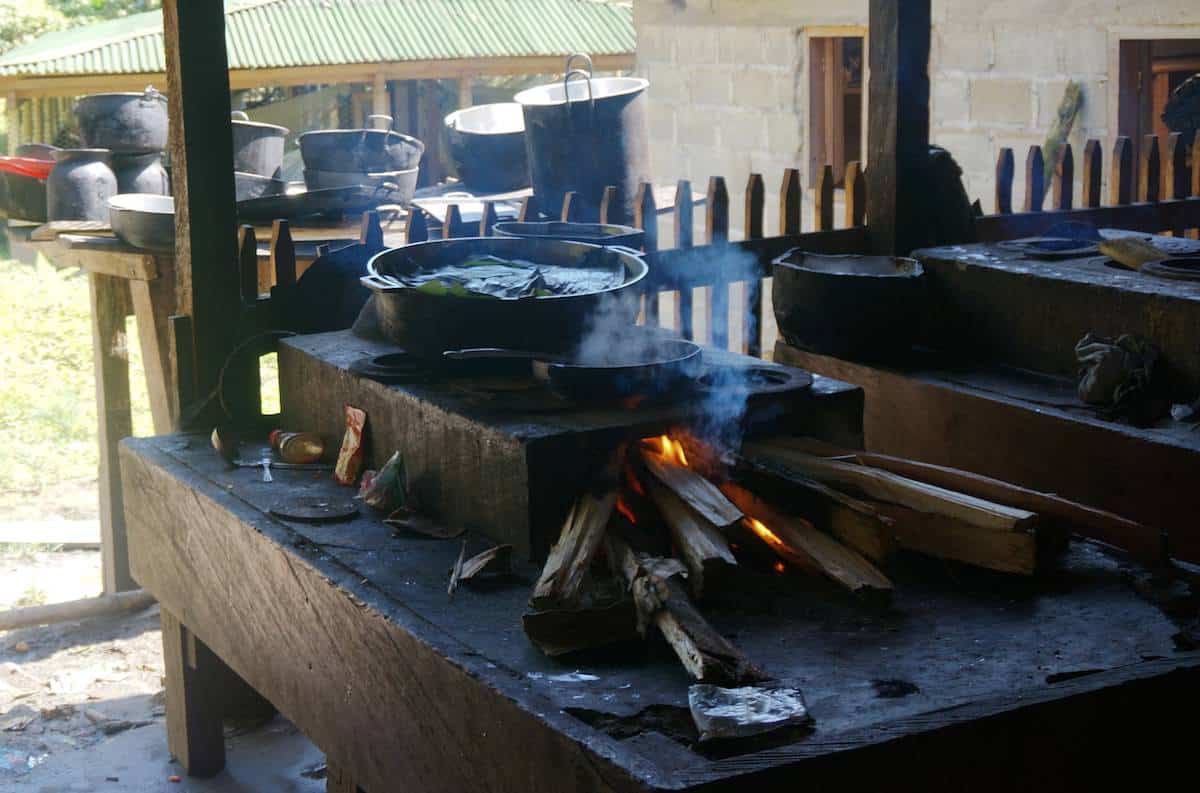
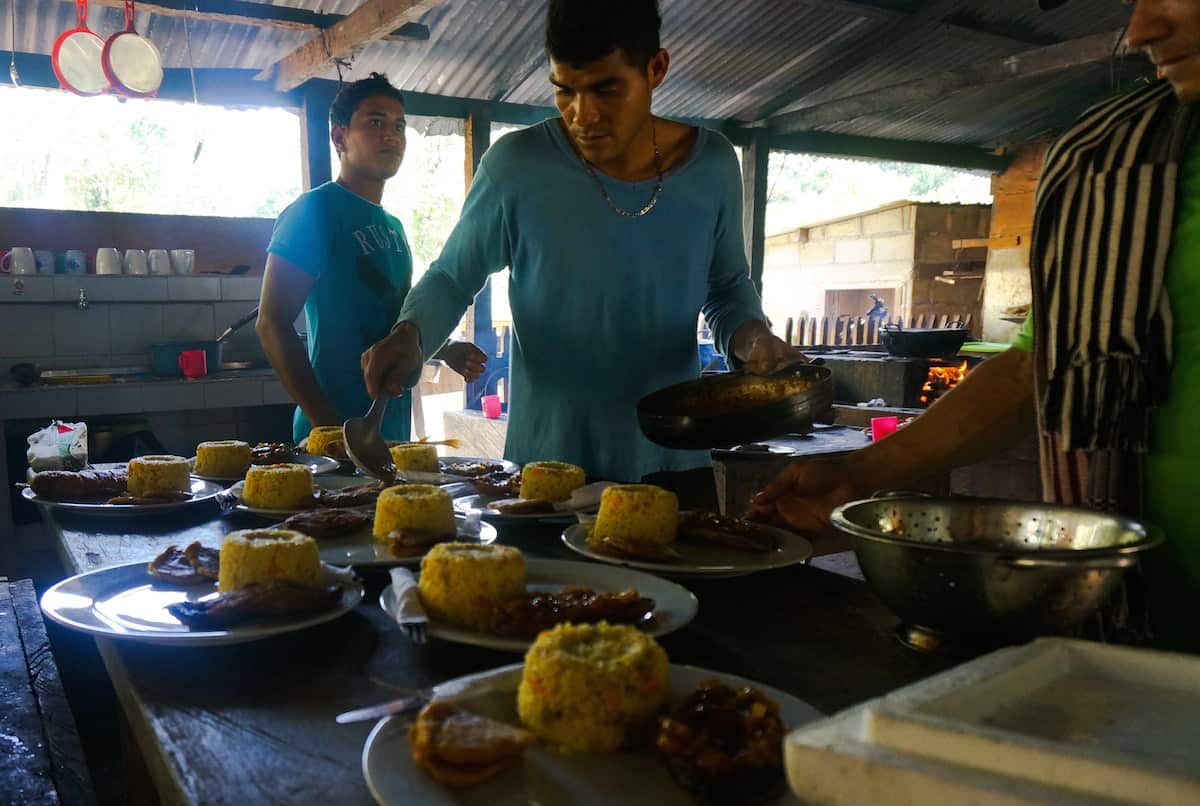
The cooks run off ahead of the group to start preparing lunch for the hikers. Using only a wood fired stove and the supplies brought in by the mules they whip up delicious meals.
THE COLORFUL & STRANGE
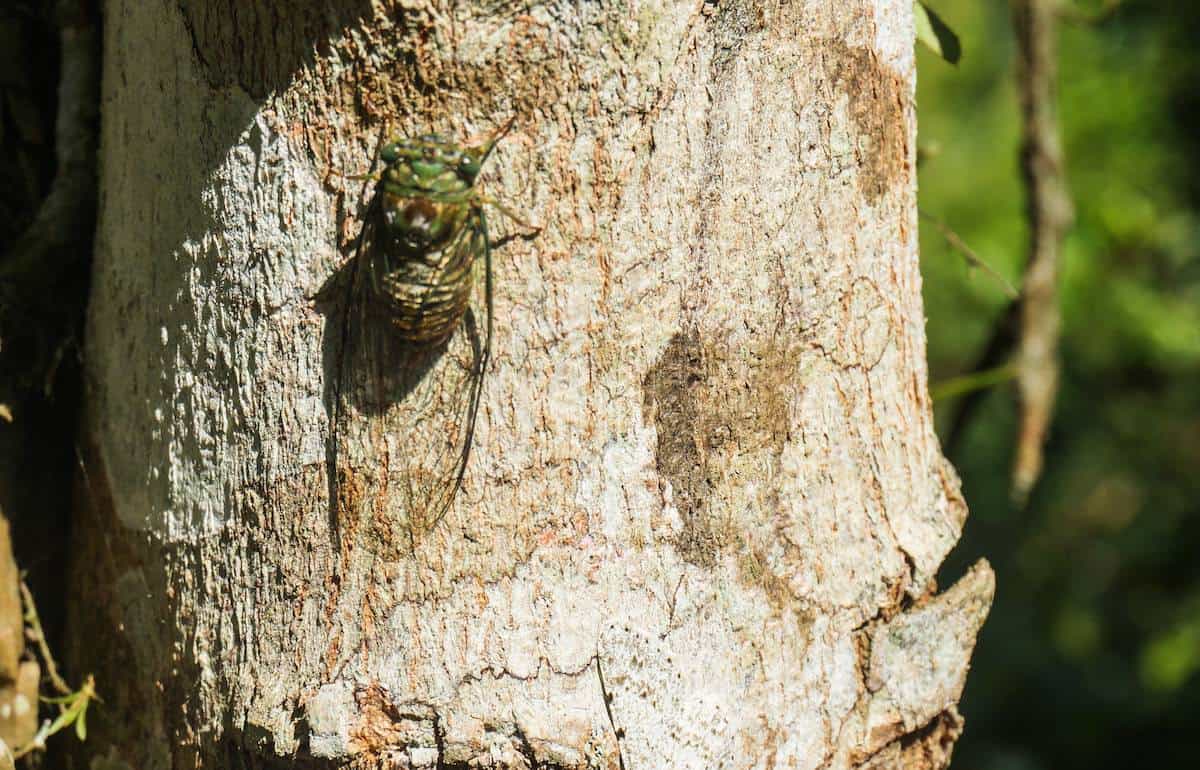
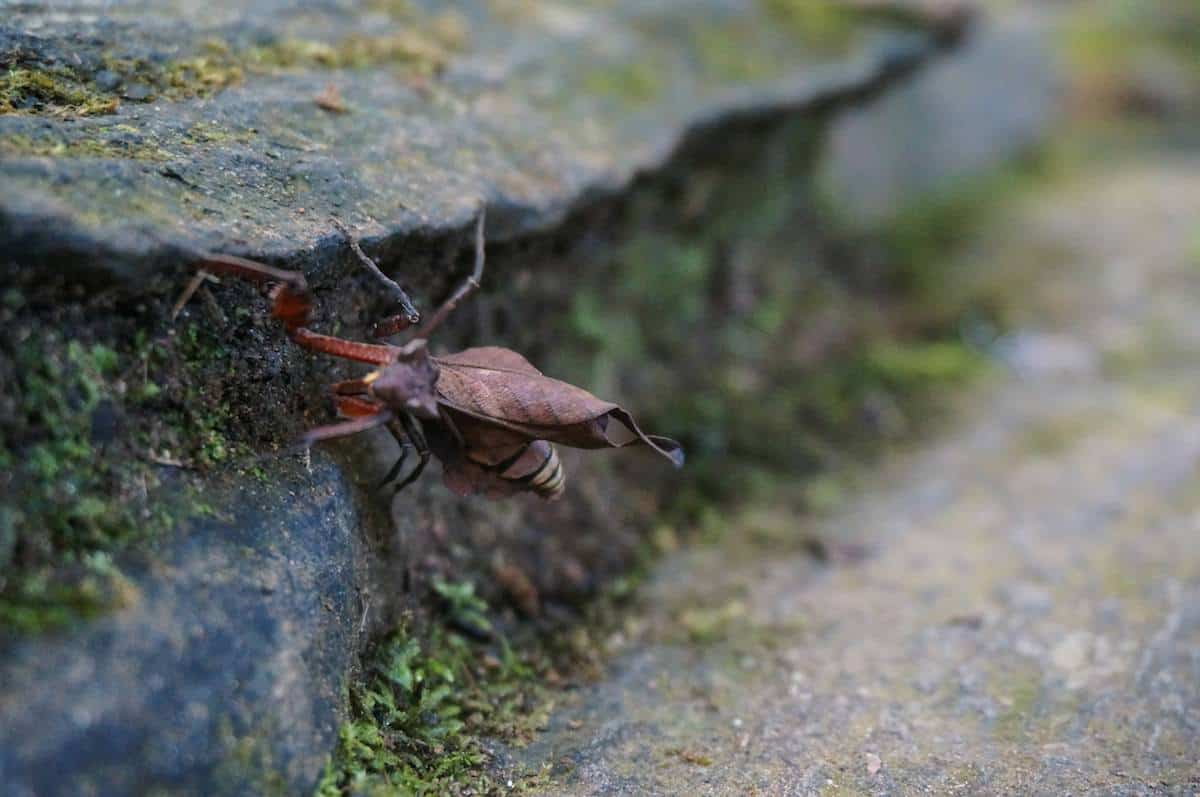
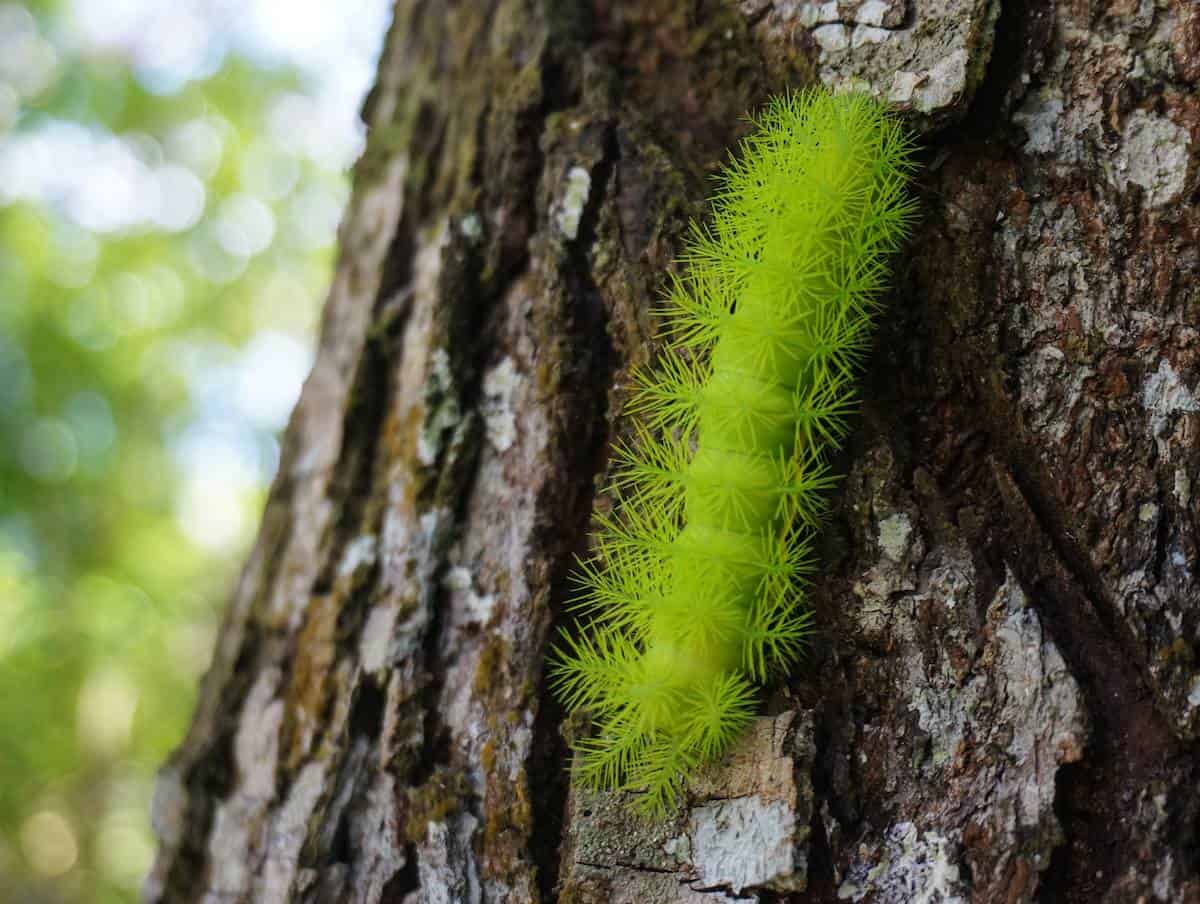
Unfortunately we didn’t see too many wild animals on this trek. Most likely because you go in a large group of chatty travelers and also because the majority of the hiking is done during the middle of the day, when the animals are least active. However we did spot some interesting jungle bugs that look like they just came out of a sci-fi movie.
KOGI KIDS
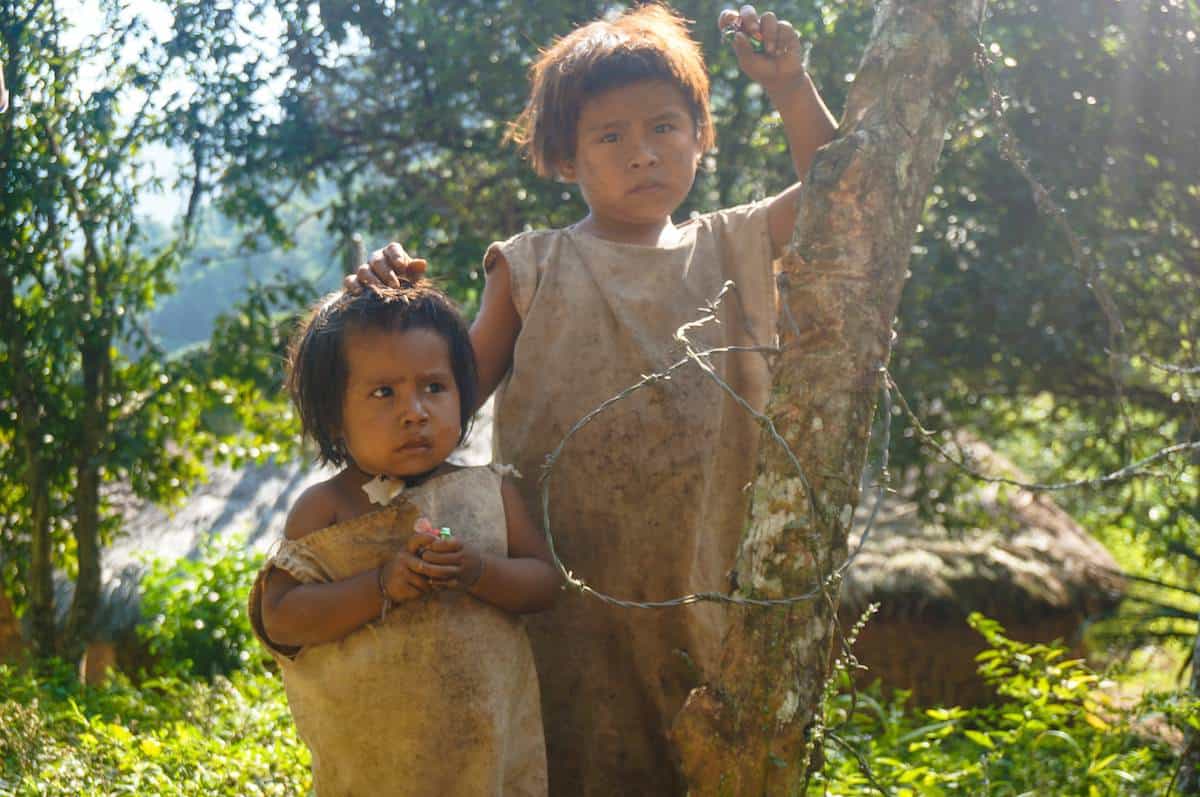
The Kogis are the descendants of the Tayrona, the indigenous peoples that built the Lost City. There are three other descendant groups that survived the Spanish conquests however the Kogis have the largest number of members who maintain their traditional customs and lifestyle.
From a young age children in the Kogi community begin to learn Spanish along with their native language. When we learned that “dulce” sweet was the first word they learn I had the impression that if we saw kids, they would demand that we hand over sweets, this was far from the case. When we stopped off along the trail at a Kogi village these two youngsters timidly walked over. They were reserved. When our guide asked if they wanted sweets they nodded. Someone from the group handed the oldest some candies and he immediately shared the treat with his little sister.
Kogi boys and girls are dressed the same in a white (or what used to be white) smock and have long hair. You can tell them apart because boys carry a small pack around their shoulder and girls wear a necklace made from animal bones.
THE WORLD HOUSE
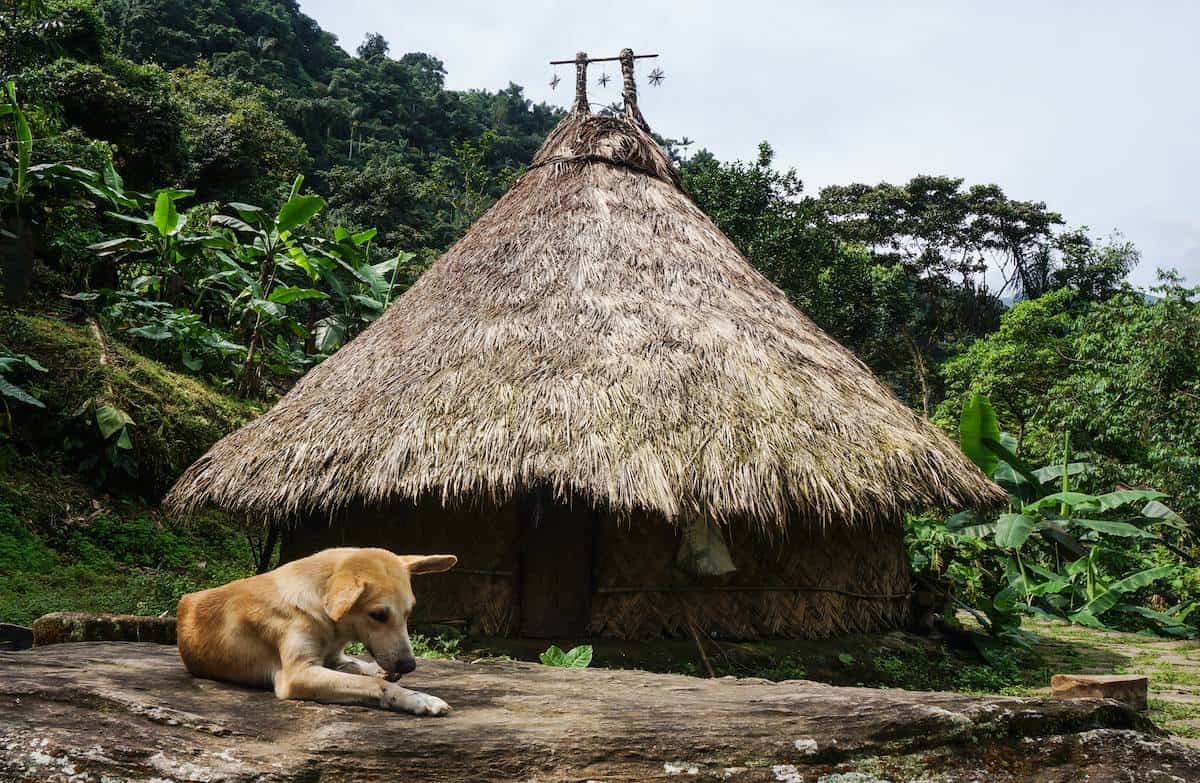
Each Kogi village has one house dedicated to gatherings. Here the “mamos”, shamans gather with the men of the village to perform spiritual ceremonies. They call this building the World House. Only men are allowed to enter, this is said because women are already spiritually higher beings and do not need to participate in the ceremonies.
IN TUNE WITH NATURE
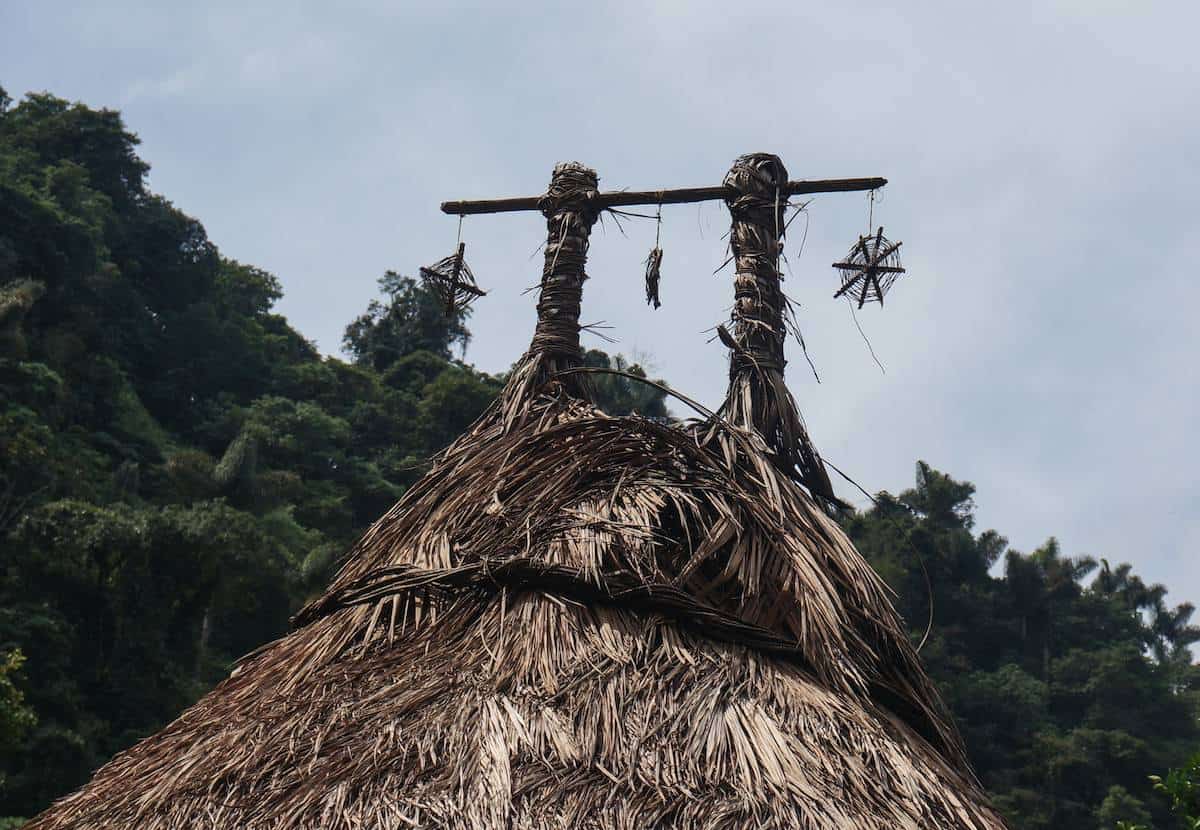
The complete way of life for the Kogis revolves around nature. Kogis believe that the two highest peaks of the Sierra Nevada de Santa Marta, Pico Colon and Pico Bolivar serve as antennas to the gods. The Kogi’s homes as well as the World House that two antennas on top that represent the two peaks. The Kogis are aware of the outside world and recognize the other high peaks of earths mountains as a network of antennas. The three pendants that you see in this picture represent the sun, the moon and the stars.
CHATTING WITH A KOGI
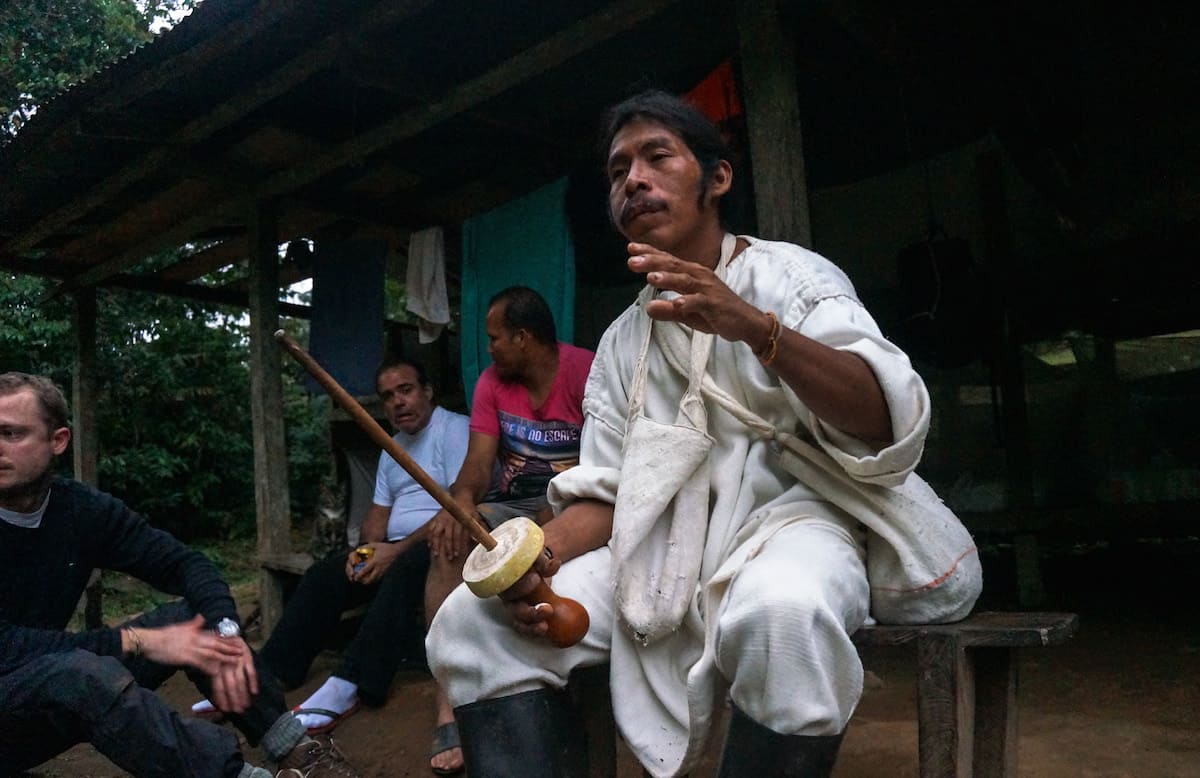
I wish I could tell you the name of this man but it was the first Kogi name I had ever heard and it has since slipped my mind. He lives nearby the trail and is good friend with the guides, he often comes by the camps to give a talk about his culture and answer any questions the hikers might have.
The man pulled out of his bag a poporo, the object you see him holding in the picture. It is made from a gourd and a wooden stick. It is a symbol of manhood, at the age of 18 boys are selected a wife by the local mamo (shaman) and he is given a poporo. The gourd represents the womb of a woman, and the stick represents the man. Inside the poporo contains burned sea shells, which is lime.
Indigenous people all over South America have been using coca leaves for centuries, it is a useful food in that it enables you to go long periods without food or sleep, it is also a source of vitamins. Yes, it is the same coca plant used to make cocaine, however in its pure form it has a very different effect from the highly addictive, chemically made product.
The kogi men place coca leaves inside their mouth and then use the stick covered in powdered lime to activate the coca. The saliva wet stick is then rubbed on the outside of the gourd. Like their ancestors, Kogis use no written language. While they are rubbing the stick on the poporo, they are meditating, thinking about positive thoughts. The lime build up is said to be the book of their lives.
THE BURITACA RIVER
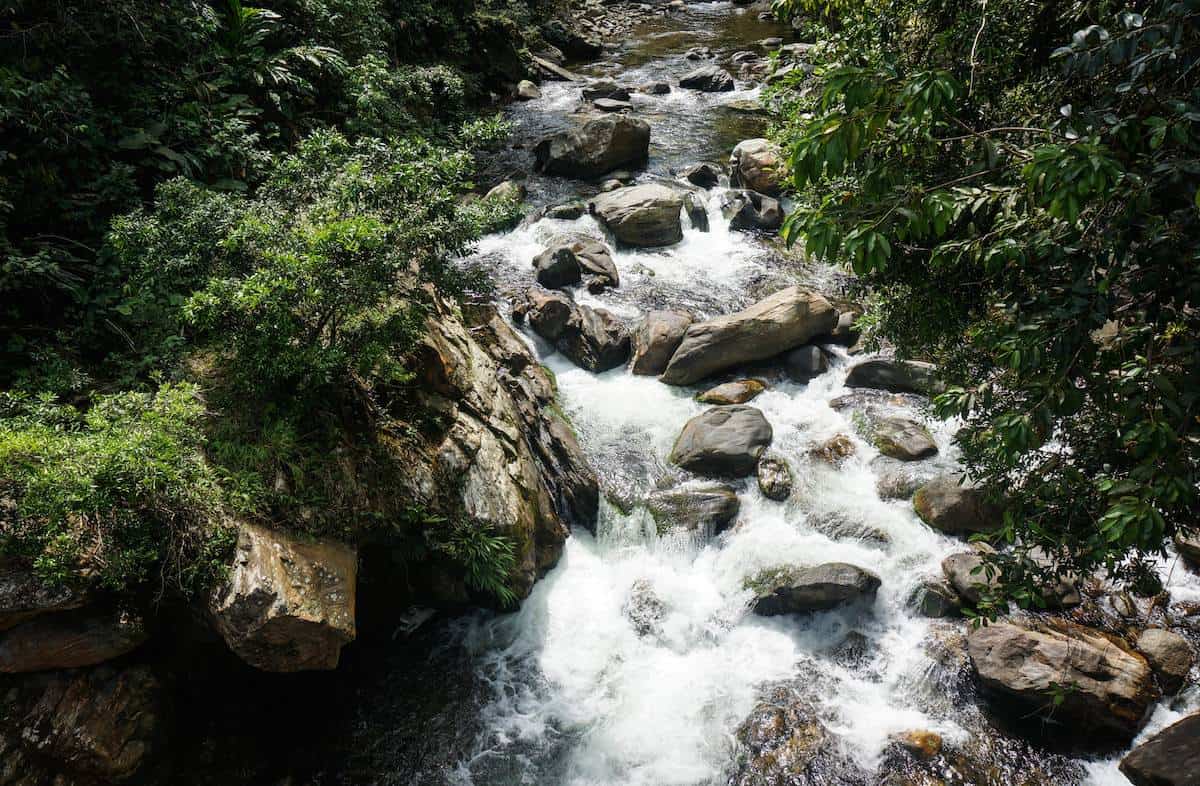
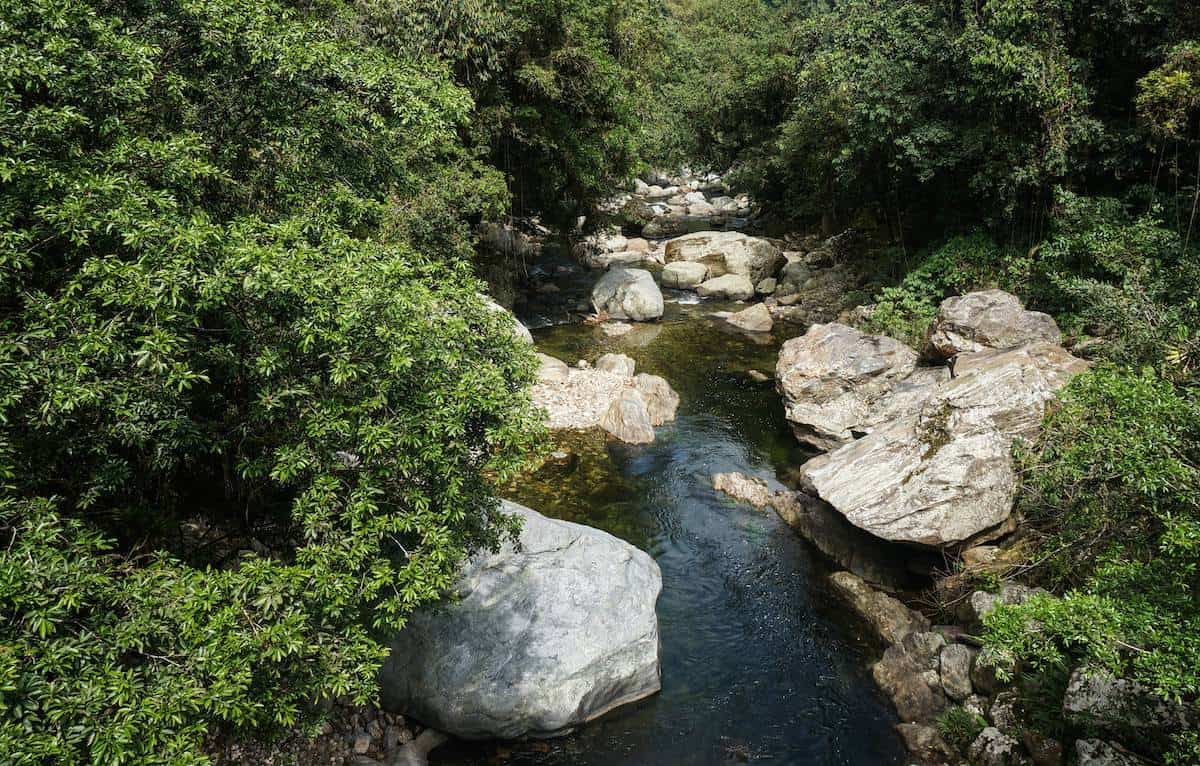
As I said before the peaks of the sierra are sacred, they are the source of life, where the rivers are born. Our guide told us in only 5 years he has seen a drastic change in water levels. Before, even in the dry season you would have to cross the river waist deep and today it hardly goes past calf level. The peaks of the sierra used to be capped with snow all year around and now they only have a few patches.
Kogis believe that humans were created to look after all living things. They believe in Alluna, the earth mother. She taught them that everything that we take from nature, even the air we breath or the water we drink we must make a payment. They make these payments through spiritual ceremonies, meditations and dances. The Kogi people call themselves the elder brothers and outsiders the younger brothers. The younger brother did not listen to the Earth Mother, he did not understand. He digs into the earth searching for petrol, ruining the Earth Mother. Regardless if you share the beliefs of the Kogi, the river level is a close reminder that we truly are changing the balance of life on earth.
SAINO
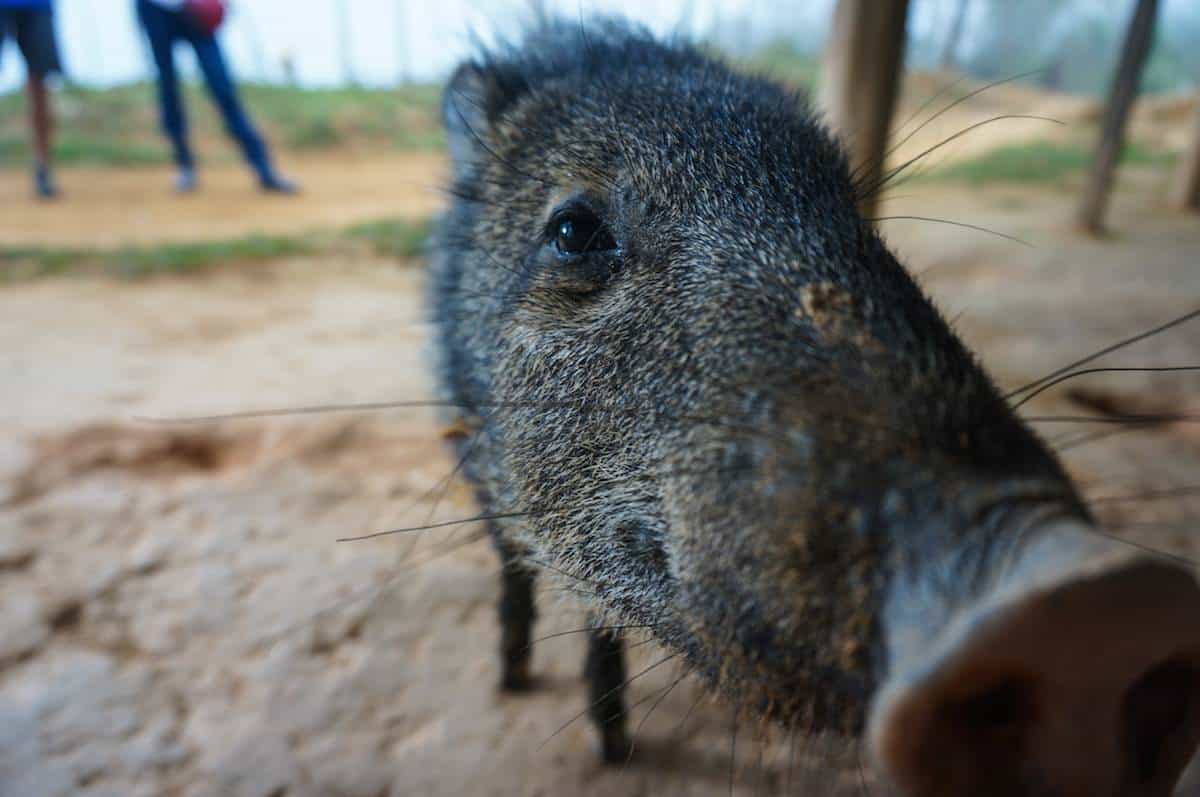
These wild boars are called sainos are part of the diet of the people of the sierra. They are very cute and friendly. This guy loved to rub his muddy snout on the hikers, we were already so smelly no one seemed to mind.
SOUNDS OF THE FOREST
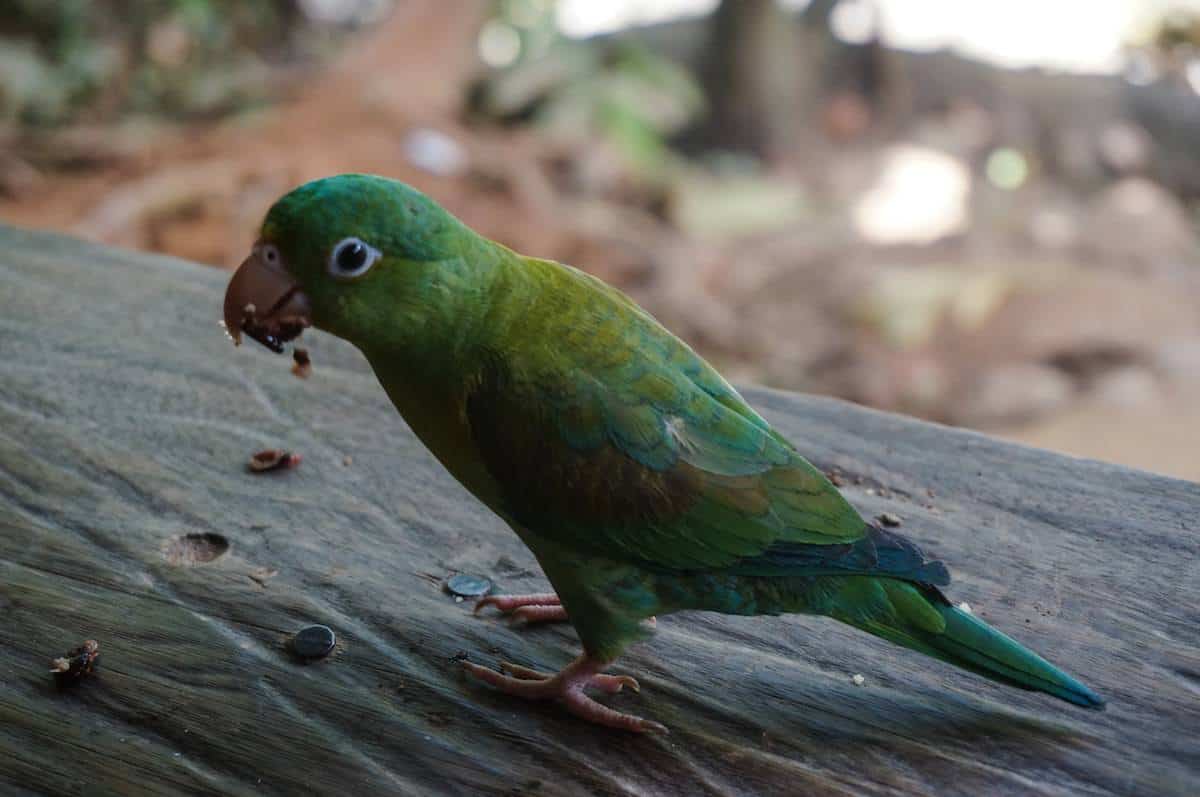
There are many beautiful and strange sounds that come from the rainforest canopy. This brightly colored baby parrot lives at one of the camps. He flew over to eat our watermelon seeds and even invited some friends a few minutes later.
THE TEYUNA ARCHEOLOGICAL PARK – CIUDAD PERDIDA
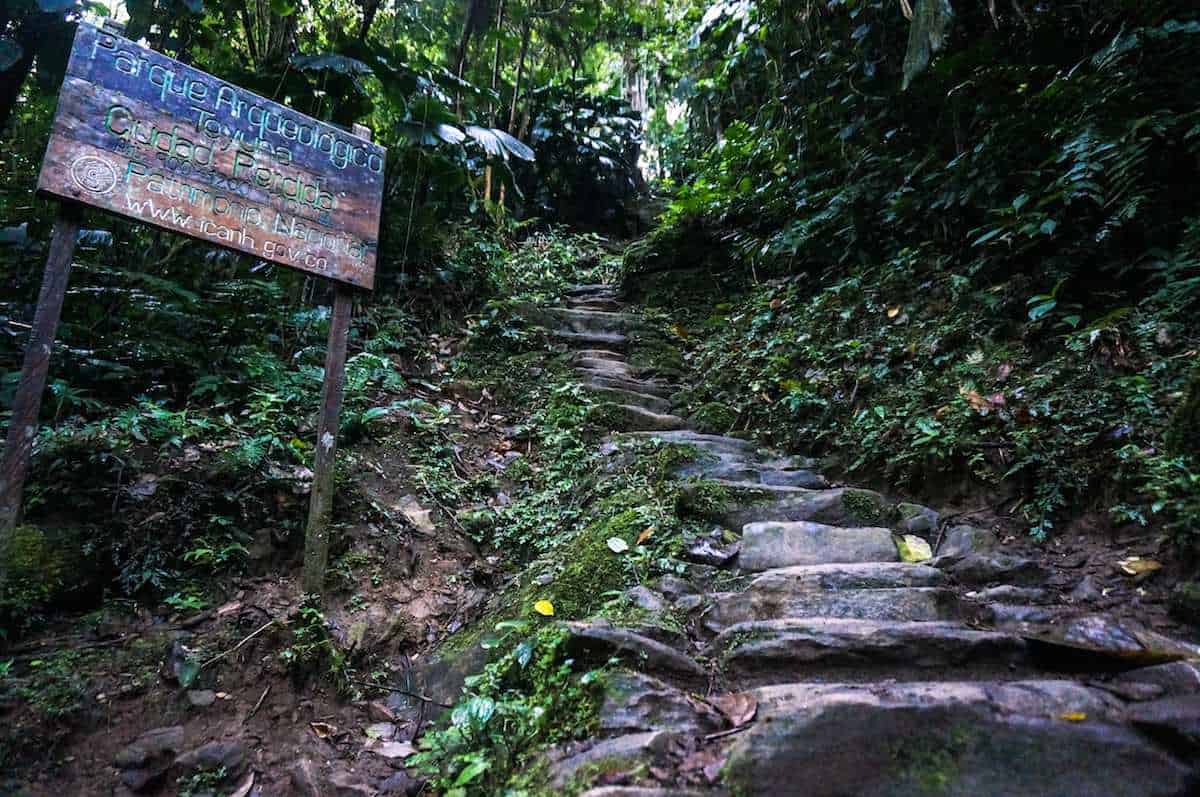
While the Kogis are said to have known about the Lost City for centuries it was first rediscovered by the outside world in 1972 when tomb robbers where looting graves of the indigenous people. The rivers were once rich in gold and the Tayrona had used it to make elaborate figures. When gold figurines began to appear in the black market, archeologists headed by the director of Instituto Colombiano de Antropologia arrived at the site in 1976 and began the reconstruction.
GOING UP!
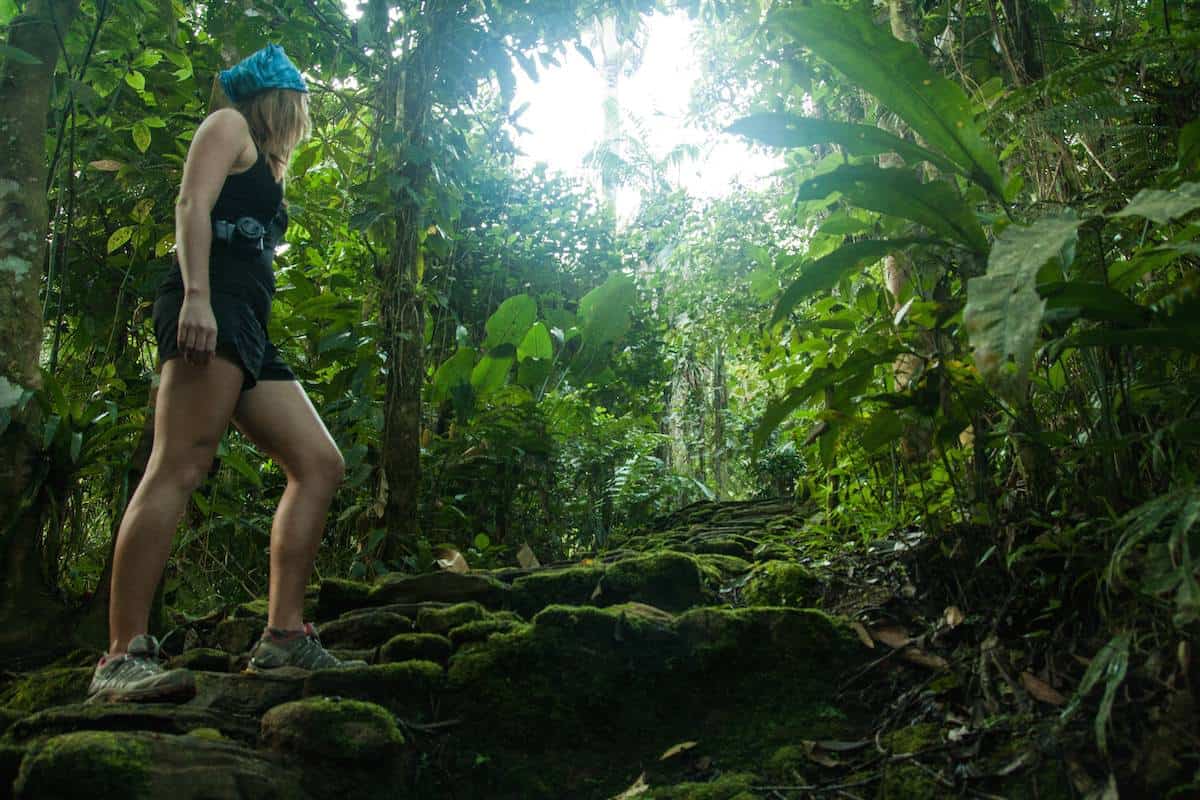
To get to the city you need to climb over 1,200 stone steps. The Tayronas were short people with small feet, some steps are so small you need to put your foot sideways.
INFIERNO VERDE
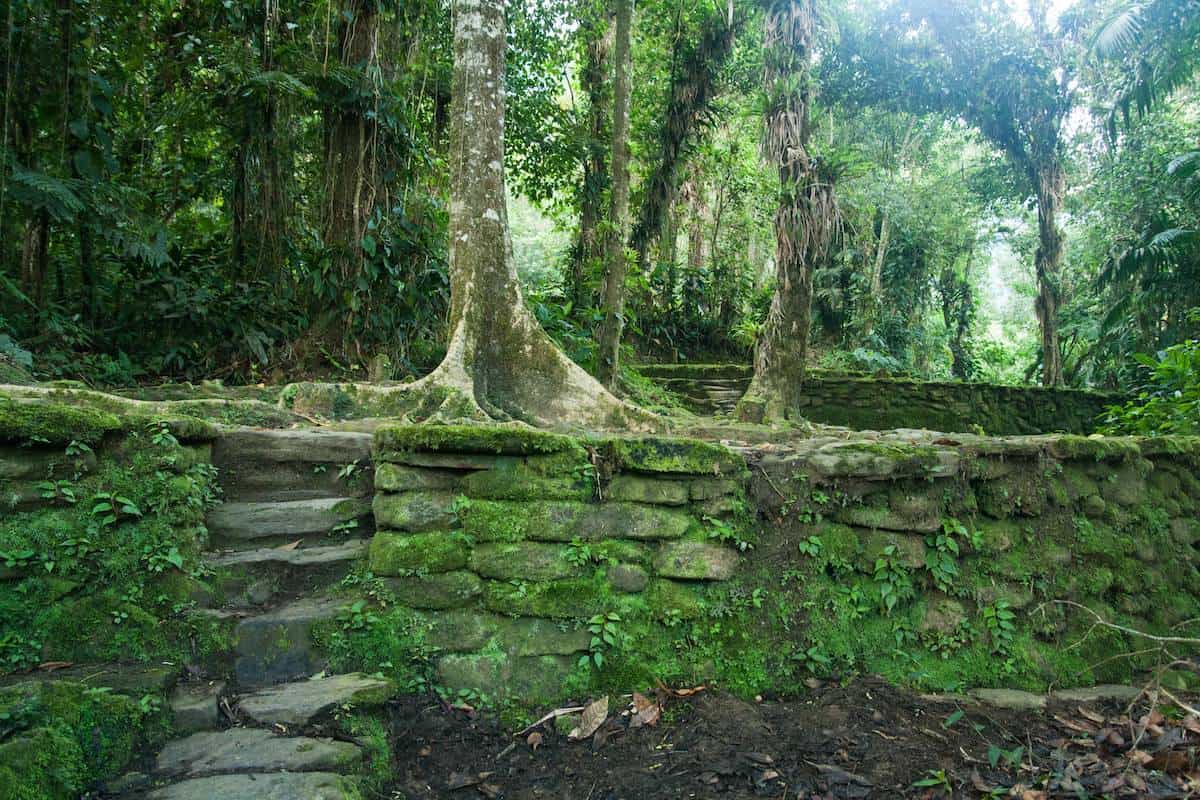
The tomb robbers that first came to rediscover in the 1970’s called the city called it “Infierno Verde”, Green Hell. It got this name because at the time the jungle had reclaimed the city and had become very dense. Everything was difficult for these thieves, cooking was sometimes impossible because all of the wood was wet, the rivers were high making it difficult to camp and you had to carry all of your food. The jungle is home to hundreds of species of venomous snakes, insects and toads in which they had no anti-venom. If that wasn’t enough, it wasn’t a safe place and many people died here due to conflicts between the grave robbers, drug producers and squatting farmers.
KITCHEN ACCESSORIES
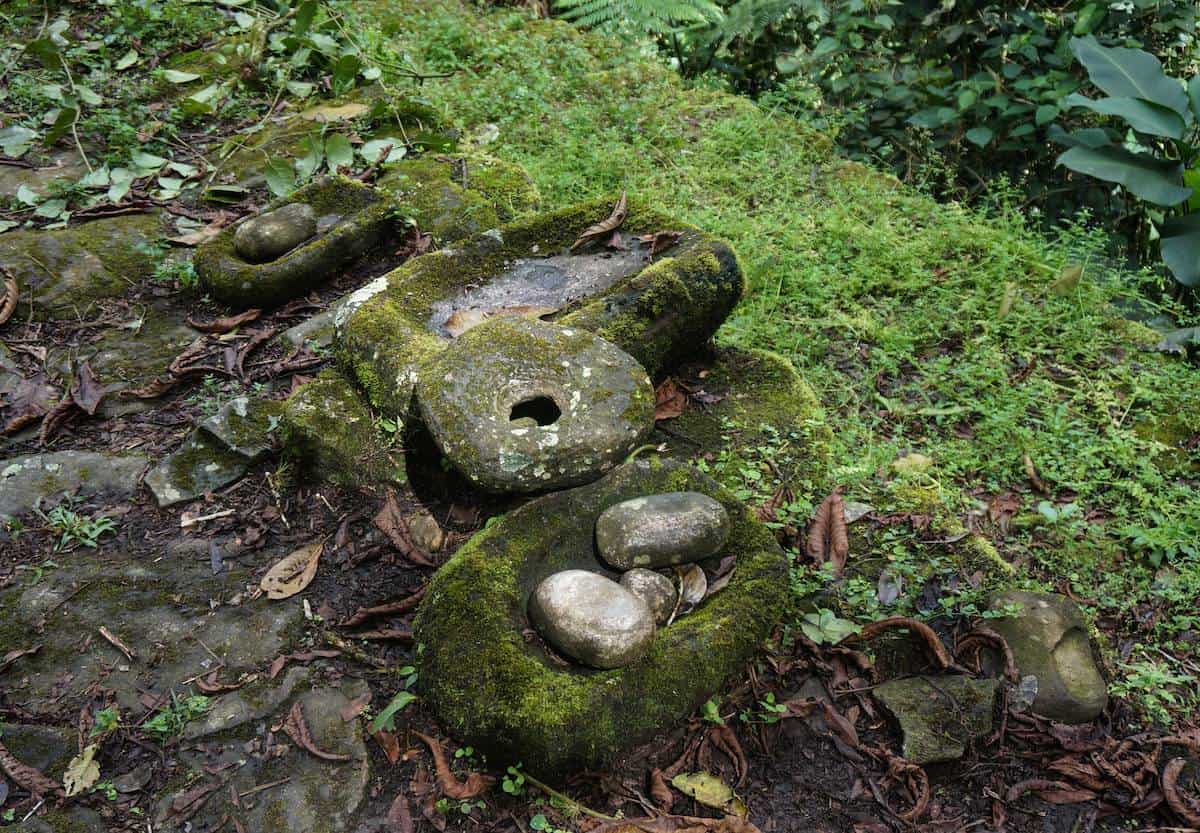
Here remains some of ancient tools that the Tayronas used to smash seeds and corn to make cereals for the children.
ANCIENT STONE MAPS
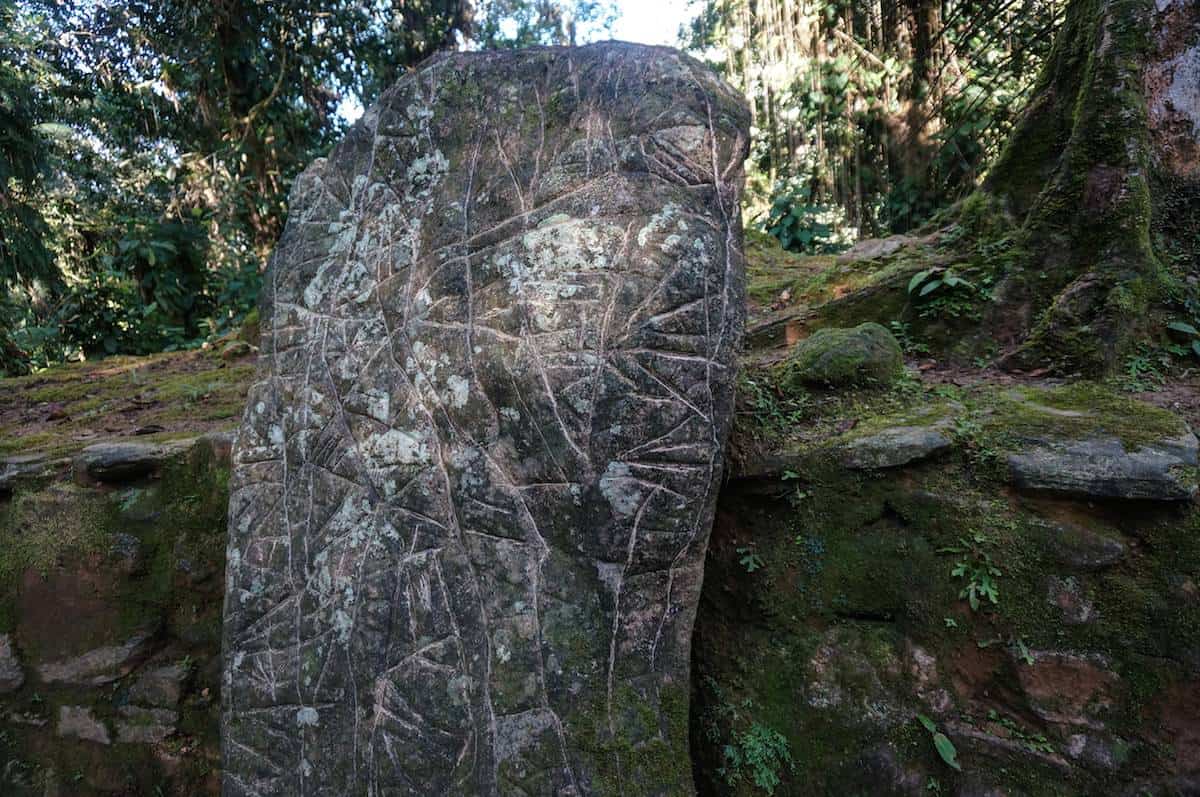
The Tayrona have no written documents and had an entirely oral tradition. However they did leave behind these maps, which they used acid from some plants to carve out. While some believe they represent the network of the Sierras, the Kogi mamos say that they are not physical maps, they do not match any lines on the ground, they are spiritual maps.
THE CENTRAL AXIS OF THE LOST CITY
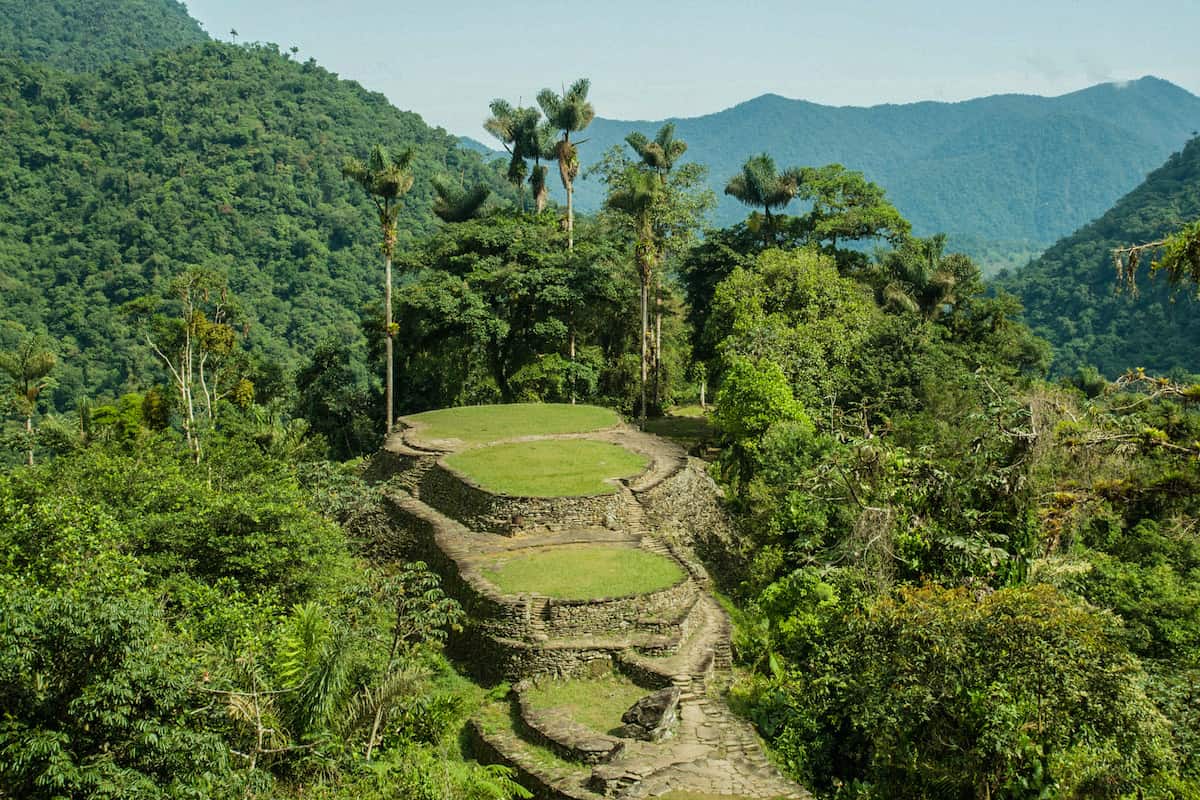
The Tayronas founded Ciudad Perdida around 800 AD. When the Spanish arrived to the area they brought with them many diseases in with the Tayrona had no cure for. On top of this there were several violent feuds between the settlers and the Tayrona. These problems led the Tayrona to abandon their cities, the survivors fled deep into the sierra while the forest vegetation reclaimed the surroundings.
The city is divided into 8 sections each of which was a space for living, working, and ceremonies. Here we are the Central Axis where it is said that the most powerful political and social leaders used to live. The ruins sit at 1,300 meter (4,265 feet) on a ridge above a valley. The stone circles you see in the photo where stone fountains for houses. The Tayrona built their homes from wood and mud rather than stones, so all that remains are these foundations.
The Kogi say that The Lost City is a spiritual site. Here you leave your negative energies and return feeling energized.
READ MORE
For more of our top hiking & backpacking gear recommendations, check out these popular buyer's guides:
Best Backpacking Sleeping Bags
Best Backpacking Sleeping Pads

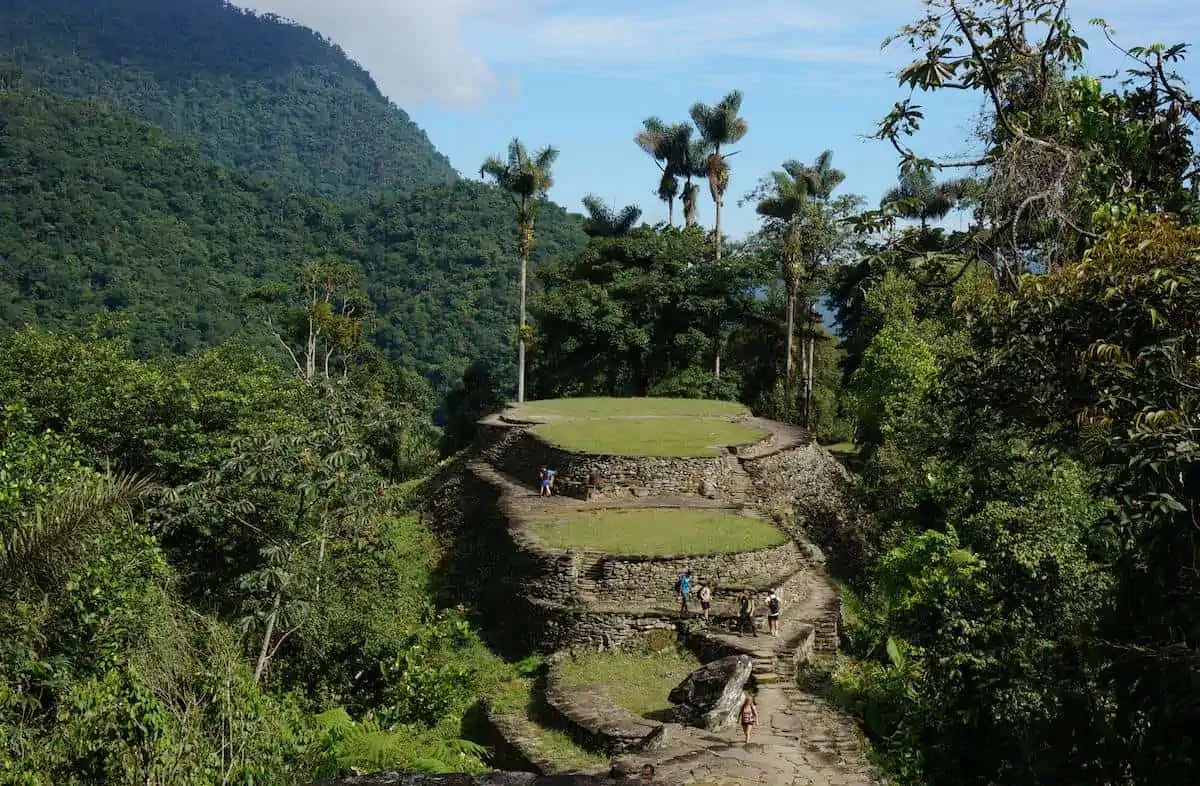
What a fantastic set of photos! These photos make you feel like you were there!
Thanks Jeremy, good to hear I achieved my goal 🙂
Great post! We spent a very short time in Tayrona National Park and it was one of the most refreshing experiences of my life! We weren’t able to hike to the Lost City… now I feel we need to return for a longer adventure!
Hey Andrea, Yes you should make your way back to Colombia, there is so much more to see. We’ve almost finished 3 months in the country and the Lost City trek is still at the top of our list of highlights!
This article was very well written. You conveyed so much powerful information about the history, culture and tradition of these people. You really did your homework. I love writers who really take the time to connect with the people which, clearly, you have done. Your photographs are also brilliant. Especially the macro shots. Great work.
Thanks for your kind words April, you just made my day!
What a fantastic photo journey, I loved the tour to this lush area!
Thanks Noel, glad you enjoyed it!
Wow! What an adventure. You got some amazing shots. That bridge makes me a bit nervous though!
Thanks Mags! Seeing the old way of crossing the river (a small metal crate that you sit in and pull yourself across) the bridge was a luxury 🙂
Absolutely gorgeous photos–I feel like I was on the trek with you (only without the risk of running into those snakes!)!
Thanks for coming along for the virtual trek 🙂
It’s really great to get out of your usual environment and witness the lives of others, isn’t it? This looks like a really incredible trip and the photos are just stunning.
Definitely! For me, that’s what makes travel so rewarding.
What a wonderful illustrated story of your journey. I loved your beautiful photos that accompanied your story. Well done!
Cheers Sue, I’m glad you enjoyed it!
What an amazing experience! I really enjoyed reading this post and seeing all the pictures. It is astonishing to see how the Kogi live their way of life.
Looks like a spectacular hike, thanks for sharing!
This was a really great post, thank you for sharing all of this wonderful information. I enjoyed reading about the Kogi people the most. I am so curious about the indigenous tribes of Latin America and I think it’s so cool you got to experience this first hand! I’ll have to keep this in mind when I go to Colombia!
Glad you enjoyed it Francesca. Meeting Kogi people was also a highlight for me. It is always interesting to see a different way of life. When are you headed to Colombia?
I can’t believe how beautiful it is! I must admit that I have never heard of this Lost City. It looks like it would be a great cultural experience though. I loved learning about the Kogi people and some of there customs!
beautiful photos! thanks for sharing! One question: since you are traveling on bikes, how do you get a backpack when you are trekking? do you rent one? is it expensive?
Thanks Luciano! We actually carry a 65L backpack each on the back of our bikes. It sits on top of the back panniers. We protect it by using a 59 L Ortlieb dry bag. Of course it adds extra weight, but if you love hiking like we do, it’s well worth the inconvenience. Renting is also an option but depending on where you want to go, there might not be a place to rent packs from. Are you planning a bicycle tour?
Many of the friends that I made in South America talked about this but I never saw pictures. That is an awesome trip.
If you ever make it to Colombia, you should definitely check out this hike Kirk.
I can only recommend this tour. I have been there at 2014. The trek to Ciudad Perdida is truly an experience and incidentally is Colombia a fantastic travel destination. On my site can also see a lot of this journey. But it is written in German with al lot of pictures, too. Here is the link http://www.alschim.de/reisen/201412_kolumbien/
This looks amazing Amanda! Thanks for this article and it’s definitely in our to do list for South America. We did a fantastic hike that reminds me a bit of this one in Guatemala, exploring the ancient Maya capital of El Mirador:
https://bestregardsfromfar.com/2016/01/10/jungle-expedition-el-mirador-guatemala/. I’m sure you would love it!